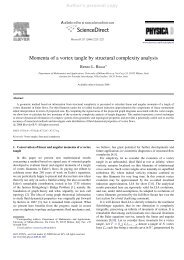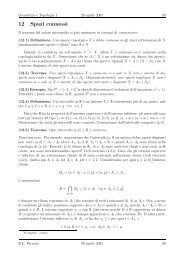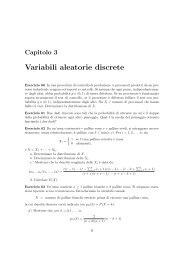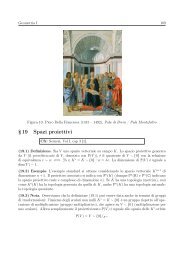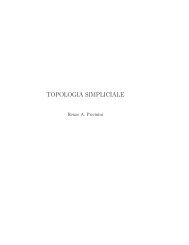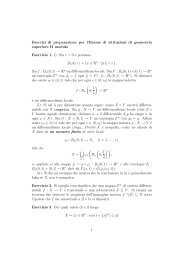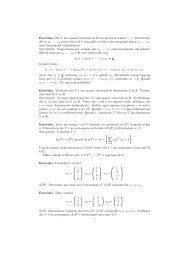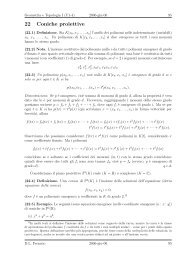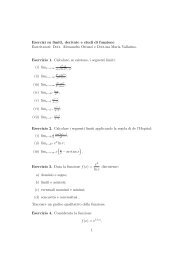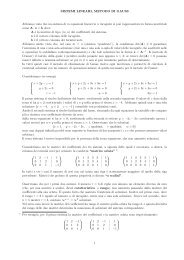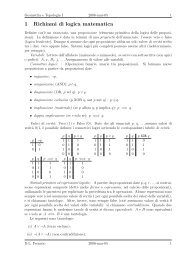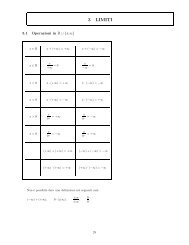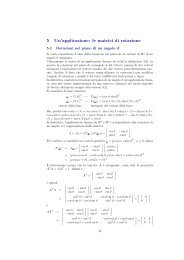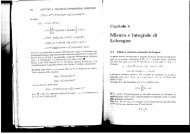Soap-film Möbius strip changes topology with a twist ... - damtp
Soap-film Möbius strip changes topology with a twist ... - damtp
Soap-film Möbius strip changes topology with a twist ... - damtp
Create successful ePaper yourself
Turn your PDF publications into a flip-book with our unique Google optimized e-Paper software.
<strong>Soap</strong>-<strong>film</strong> Möbius <strong>strip</strong> <strong>changes</strong> <strong>topology</strong><strong>with</strong> a <strong>twist</strong> singularityRaymond E. Goldstein a , H. Keith Moffatt a,1 , Adriana I. Pesci a , and Renzo L. Ricca baDepartment of Applied Mathematics and Theoretical Physics, University of Cambridge, Wilberforce Road, Cambridge CB3 0WA, United Kingdom; andbDepartment of Mathematics and Applications, University of Milano-Bicocca, Via Cozzi, 53, 20125 Milan, ItalyContributed by H. Keith Moffatt, October 26, 2010 (sent for review September 17, 2010)It is well-known that a soap <strong>film</strong> spanning a looped wire can havethe <strong>topology</strong> of a Möbius <strong>strip</strong> and that deformations of the wirecan induce a transformation to a two-sided <strong>film</strong>, but the processby which this transformation is achieved has remained unknown.Experimental studies presented here show that this process consistsof a collapse of the <strong>film</strong> toward the boundary that producesa previously unrecognized finite-time <strong>twist</strong> singularity that<strong>changes</strong> the linking number of the <strong>film</strong>’s Plateau border and thecenterline of the wire. We conjecture that it is a general featureof this type of transition that the singularity always occurs at thesurface boundary. The change in linking number is shown to be aconsequence of a viscous reconnection of the Plateau border atthe moment of the singularity. High-speed imaging of the collapsedynamics of the <strong>film</strong>’s throat, similar to that of the central openingof a catenoid, reveals a crossover between two power laws. Farfrom the singularity, it is suggested that the collapse is controlledby dissipation <strong>with</strong>in the fluid <strong>film</strong> surrounding the wire, whereascloser to the transition the power law has the classical form arisingfrom a balance between air inertia and surface tension. Analyticaland numerical studies of minimal surfaces and ruled surfaces areused to gain insight into the energetics underlying the transitionand the <strong>twist</strong>ed geometry in the neighborhood of the singularity.A number of challenging mathematical questions arising fromthese observations are posed.topological transition ∣ contact lineIn an elegant article in 1940 (1), the mathematician R. Courantlaid out a number of fundamental questions about surfaces ofminimal area that could be visualized <strong>with</strong> soap <strong>film</strong>s spanningwire frames of various shapes. He noted that when the frameis a double loop it can support a <strong>film</strong> <strong>with</strong> a Möbius <strong>strip</strong> <strong>topology</strong>.Pulling apart and un<strong>twist</strong>ing the loop leads to an instabilitywhereby the <strong>film</strong> jumps <strong>with</strong> change of <strong>topology</strong> to a two-sidedsolution (Fig. 1). From splitting fluid drops (2) to reconnectingsolar magnetic field lines (3), such topological transitions (4)abound in nature and are often associated <strong>with</strong> singular structuresthat evolve rapidly to a new state. The study of minimal surfacesdates back to the work of Euler (5) and Lagrange (6). “Plateau’sproblem,” that of proving the existence of a minimal surface spanninga given contour, was solved in the 1930s (7–9), and subsequentmathematical work has focused chiefly on statics, involving,for example, proofs of the existence of such surfaces of prescribed<strong>topology</strong> in higher dimensions, classification of periodic minimalsurfaces (10), and classification of embedded surfaces (11). Withfew exceptions, such as a study of the transition between thehelicoid and the catenoid (12), little attention has been paid totransitions that take one surface to another. On the other hand,topological transitions have been studied extensively in fluiddynamics, <strong>with</strong> an emphasis on interface collapse in viscous flows(2, 4), and on the more inviscid problems of fluid and soap-<strong>film</strong>motion (13–18) and networks of <strong>film</strong> junctions (19). Yet oneelementary question remains unanswered: What is the processthat takes a one-sided <strong>film</strong> to a two-sided one?We report experimental and theoretical results on four centralissues raised by this question. We find that the singularity (i)Fig. 1. Topological transition of a soap-<strong>film</strong> Möbius <strong>strip</strong>. As its frame isgradually distorted, a critical point is reached at which the one-sided <strong>film</strong>(A) transforms rapidly to a two-sided <strong>film</strong> (B). Scale bar in A is 2 cm.occurs at the <strong>film</strong> boundary, (ii) lacks the cylindrical symmetryfound in the collapse of a catenoid (13), or even the bilateralsymmetry recently observed in bubble pinch off (20), and <strong>changes</strong>the linking number between the Plateau border and the centerlineof the wire frame, (iii) displays an intriguing crossover froma nonclassical behavior in the collapse of the <strong>film</strong> to the morefamiliar one arising from a balance of capillary forces and airinertia (15, 21), and (iv) has energetics and geometry that maybe understood through analysis of minimal surfaces and ruledsurfaces spanning a family of parametrized frames (22).Results and DiscussionFilm Collapse Changes Linkage of Plateau Border and Frame. Removingthe wire frame from the soap solution (see Materials and Methods),one typically finds (1) it necessary to destroy a small centraldisc-shaped <strong>film</strong> to obtain the Möbius <strong>strip</strong>. Gradually pullingapart the two loops then produces a narrow neck (or throat)(Fig. 1A) similar to a catenoid spanning two rings (13). Lookingdown this throat one sees an approximately circular boundarymeeting the frame, a situation considered recently (23), but thegeometry is now decidedly <strong>twist</strong>ed and asymmetric. Once unstablethe neck collapses, leaving a two-sided surface (Fig. 1B).To illustrate the wire deformation during the process describedabove, it is helpful to introduce a particular representation (22) ofthe unfolding loop through the one-parameter family of curvesC∶xðμ;θÞ ¼ðx;y;zÞ <strong>with</strong> μ ¼ −1 and 0 ≤ θ < 2π, wherexðμ;θÞ ¼½μτ cos θ þð1 − τÞ cos 2θŠ∕lðτÞ;yðμ;θÞ ¼½μτ sin θ þð1 − τÞ sin 2θŠ∕lðτÞ;[1a][1b]Author contributions: R.E.G., H.K.M., A.I.P., and R.L.R. designed research, performedresearch, analyzed data, and wrote the paper.The authors declare no conflict of interest.1To whom correspondence should be addressed. E-mail: h.k.moffatt@<strong>damtp</strong>.cam.ac.uk.This article contains supporting information online at www.pnas.org/lookup/suppl/doi:10.1073/pnas.1015997107/-/DCSupplemental.APPLIEDMATHEMATICSwww.pnas.org/cgi/doi/10.1073/pnas.1015997107 PNAS ∣ December 21, 2010 ∣ vol. 107 ∣ no. 51 ∣ 21979–21984
Fig. 3. Details of the <strong>twist</strong> singularity. The <strong>twist</strong>ed Plateau border far from the collapse time (A) is shown schematically in B as a red line wrapping around thewire (gray). Just after the collapse (C) the border is <strong>twist</strong>ed around the frame as shown in D and produces the caustic in C. Note the reversal of the sense of <strong>twist</strong>between A and C.<strong>strip</strong>, but “…there also exists a minimal surface bounded by thesame contour having the ordinary <strong>topology</strong> of a circular disc; butthis other surface is self-intersecting, and it is rather the onesidedsurface which is obtained in the actual experiment.” It iscertainly true in our experiments that upon removing a given wireframe of this shape from the soap solution one never finds a twosidedsurface. It is the Möbius <strong>strip</strong> <strong>with</strong> the additional central<strong>film</strong> that is the most commonly obtained configuration; theMöbius <strong>strip</strong> by itself seldom happens. However, the two-sidedsolution for this configuration of the wire can be obtained, asdescribed above, by distorting the frame and returning it tothe initial position once the Möbius <strong>strip</strong> has collapsed. That thisnew configuration is stable is an indication of the hysteresis in thissystem.The fact that we have obtained a nonintersecting two-sidedminimal surface spanning the double-covered circular contourapparently contradicts Douglas’s remark. The resolution of thisapparent discrepancy resides in the finite thickness of the wire,which regularizes what would otherwise be a singularity. Weshould also note that Douglas studied the location of the singularitieson the two-sided minimal surfaces bounded by a contourof zero size, whereas we have performed experiments where thesingularity occurs when the <strong>film</strong> is supported by a finite size contour(the wire). To make a comparison between Douglas’sresults and the experimental ones, it would be necessary to studythe limit of the wire radius approaching zero after the singularityhas developed; but this limit inverts the order of the limitingprocesses implicitly considered by Douglas. Because we alreadyknow that there is hysteresis in the system, one would expectthat the outcomes of these two different routes toward the singularitymay not yield the same result. As is described in thefollowing section, we observe that the singularity develops atthe wire frame (surface boundary), a fact that should not be consideredas a contradiction to Douglas’s theorem stating that thetwo-sided surface spanning the contour has a singularity in itsinterior, but simply as a consequence of the different approachesto the singularity.The Singularity Occurs at the Film Boundary. Careful manipulationof the wire frame has allowed us to trigger the instability of theMöbius <strong>strip</strong> <strong>film</strong> on demand, so that high-speed movies of thatprocess can be reliably obtained (see Materials and Methods). Thecollapse process itself typically takes about 0.1 s. Fig. 4 A–D areframes from a high-speed movie at 5.4-ms intervals showing theapproach to the singularity and the collision of the surface throat<strong>with</strong> the frame. The contrast enhancement achieved by the use offluorescein in the <strong>film</strong> allows us to trace the whole projectedshape of the collapsing throat <strong>with</strong> an edge-detection algorithm.Extensive experimentation has shown that the only route to thetwo-sided solution from the Möbius <strong>film</strong> is via a singularity at theboundary wire. In fact, the singularity never occurs away from theboundary, even in the presence of the second (disc-shaped) <strong>film</strong>.This is as one would expect because, as explained above, not onlydoes the bulk of the <strong>film</strong> undergo a topological transition (onesidedto two-sided), but the boundary itself participates in thistransition. We conjecture that in general any singularity associated<strong>with</strong> such a transition must always occur at the <strong>film</strong> boundarybecause, as we have noted, the linking number of the wirecenterline and the Plateau border <strong>changes</strong> from 2 to zero at thetransition, and this linking number, here defined for two closelyadjacent curves (coincident in the limit as the wire radius tendsto zero), clearly cannot be changed by a singularity on the <strong>film</strong> atany finite distance from the boundary. Translating this abstractargument to the experimental context is however nontrivial, foralthough the singular rearrangement of the Plateau border mustoccur at some point of the wire, it is by no means evident that thecollapsing surface is always directly driven to this point; yet that iswhat is observed (Fig. 4).Dynamics of the Finite-Time Singularity. When a minimal area soap<strong>film</strong> becomes unstable due to boundary deformation, there is a netresultant of surface-tension forces driving its motion. From moviesof this collapse we extract a time-dependent throat diameterDðtÞ, the distance between the wire and the <strong>film</strong> (Fig. 4A). Fig. 5shows the width DðtÞ, for three runs, measured <strong>with</strong> respect tothe apparent pinch time t p . In this log–log plot we see a crossoverat t p − t ∼ 5 × 10 −3 s between two distinct regimes of power-lawbehavior, D ∼ ðt p − tÞ ν . Fitting the data asymptotically close tothe singularity (t p − t ≲ 0.003) we find ν 1 ¼ 0.67 0.02, whereasfar from the singularity (t p − t ≳ 0.015), we obtain the exponentν 2 ¼ 0.33 0.02. When the force on the <strong>film</strong>, proportional tothe product of the surface tension σ and the local mean curvatureH, is resisted only by the inertia of air, <strong>with</strong> mass density ρ thendimensional arguments (15) and boundary-integral formulations(21) show that the width should vanish as D ∼ ðσ∕ρÞ 1∕3 ðt p − tÞ 2∕3 ,in good agreement <strong>with</strong> the observed exponent ν 1 . To our knowl-APPLIEDMATHEMATICSGoldstein et al. PNAS ∣ December 21, 2010 ∣ vol. 107 ∣ no. 51 ∣ 21981
Fig. 4. Collapse of the Möbius <strong>strip</strong> throat. (A–D) Frames from a high-speed movie at 5.4-ms intervals show the approach to the singularity and collision <strong>with</strong>the frame. The throat diameter D used to quantify the collapse dynamics is indicated in A.edge, the exponent ν 2 observed far from t p has not been reportedpreviously in contexts such as this. As this occurs when the interfaceis beginning its motion, it is reasonable to suspect that theYoung–Laplace force would be balanced by dissipation. Examiningmovies of the collapse we observed that at the onset of collapsethere is torsional motion of the Plateau border as the <strong>twist</strong> isfocused toward an ever smaller segment of the wire (Fig. 4).An application of lubrication theory similar to ref. 33 to calculatethe viscous forces <strong>with</strong>in the wetting <strong>film</strong> on the wire yields theequation of motion D 2 _ D ∼ σh 2 ∕3μ, where h is a typical thicknessof the <strong>film</strong> and μ is the fluid viscosity. This has the solutionD ∼ ðσh 2 ∕μÞ 1∕3 ðt p − tÞ 1∕3 , an exponent consistent <strong>with</strong> the experimentalvalue of ν 2 (Fig. 5).Geometry of Twist Singularity and Surface Energetics. As equilibriumsoap <strong>film</strong>s minimize their surface area, the transition from oneto two sides must lower the energy. The energetic competitionamong minimal surfaces can be studied numerically by usingthe computational routine Surface Evolver (34) to find the stablesurface(s) that span curve C for various τ. Here we implementthis calculation <strong>with</strong> a boundary of zero thickness [as in Douglas’sanalysis (9)] and therefore do not address any effects of thePlateau border. As described in Materials and Methods, the calculationsare done on surfaces of a fixed <strong>topology</strong>, determined bythe connectivity of the coarse initial grid that defines the surface.We find that stable two-sided solutions exist for 0.41 ≲ τ ≤ 1,whereas stable Möbius <strong>strip</strong> solutions are found in the range 0 τ 1 ¼2 − ffiffi2 ≈ 0.586, the surface is self-intersecting on a straight linesegment (35). This may be shown by seeking parameter pairsðμ;θÞ and ðμ 0 ;θ 0 Þ that yield the same values of x, y, and z inEq. 1; such pairs indeed exist for τ > τ 1 . The minimal area soap<strong>film</strong> obviously cannot share this feature of self-intersection. Second,when τ increases through the critical value τ 2 ¼ 2∕3, theprojection of C on the plane z ¼ 0 loses its loop, being cusped atθ ¼ 0 for τ ¼ τ 2 . Therefore, at τ 2 , the hole through the one-sidedsurface S disappears: Its genus falls from 1 to zero (Fig. 7). Third,when τ is further increased through the critical value τ 3 ¼ 4∕5,the bounding curve C passes through an “inflexional configuration”;i.e., there is instantaneously an inflexion point of zerocurvature on C, Q say (36). At τ 3 , the torsion at Q is infinite,but the singularity is integrable; in fact, it is at τ 3 that the internal<strong>twist</strong> of the wire jumps from zero to 1 (31).Even though the ruled surface Eq. 1 self-intersects for τ > τ 1 ,i.e., even before the throat disappears, it nevertheless providesqualitative insight into features of the surface as it approachesthe singularity. At τ ¼ τ 2 , as mentioned above, the projection ofC on the plane z ¼ 0 is cusped at θ ¼ 0; for τ > 2∕3, this projectionhas no reentrant loop. When τ ¼ τ 2 , C has the form nearθ ¼ 0 of the <strong>twist</strong>ed cubic <strong>with</strong> local parametric equations (<strong>with</strong>~x ¼ lx, etc.)~x ≃ − 1 3 − 1 3 θ2 ; ~y ≃ − 1 3 θ3 ; ~z ≃ − 4 θ: [3]9Fig. 5. Dynamics of the topological transition. The time dependence of thethroat diameter D, for three typical separate events (colored symbols). Redlines indicate best-fit power laws, <strong>with</strong> exponent ν 1 ≃ 0.67 0.02 close to thesingularity and ν 2 ≃ 0.33 0.02 far from the pinch time t p .Fig. 7 shows the projection of a portion of the surface−1 < θ < 1, −1 < μ < −0.9 on the xy plane for values of τ nearthe critical value τ 2 ¼ 2∕3, showing how the hole disappears whenthe cusp in the boundary curve μ ¼ −1 is apparent. Close examinationshows that the singularity that appears to propagate21982 ∣ www.pnas.org/cgi/doi/10.1073/pnas.1015997107 Goldstein et al.
Fig. 6. Energy and geometry of surfaces. (A) Numerically obtained minimal surfaces (gray) and ruled surfaces (copper) as a function of the model parameter τ.Black and red filled circles indicate the minimal energy for the two classes of surfaces. The blue line is the energy of the ruled surface. (B) Two views of thesurface geometry for τ beyond the limit of stability of the one-sided surface, where surface is evolving toward a singularity by the numerical relaxation schemeand the evolution has been terminated just prior to the singularity. (C) The universal “<strong>twist</strong>ed saddle” geometry from the ruled surface model. Note similarity<strong>with</strong> the throat in B.toward the center of the disc for τ > τ 2 is in fact a <strong>twist</strong>ed fold (orcusp catastrophe); defining τ ¼ 2ð1 − τÞ and scaled variablesX ¼ τ ð~x þ τ ∕2Þ, Y ¼ τ 2 ~y, Z ¼ ~z∕τ its local equation can beexpressed in the universal form12 Z3 þ XZ þ Y ¼ 0. [4]This <strong>twist</strong>ed saddle structure (Fig. 6C) constitutes an idealizedapproximation to the observed <strong>film</strong> structure, as well as thatobtained numerically (Fig. 6B), and reveals how the <strong>twist</strong> ofthe surface imposed by the distant boundary may persist at thetransition.ConclusionsThe results presented here indicate that the topological rearrangementof a soap <strong>film</strong> is far more subtle than previously thought.Although the transition from a one-sided to a two-sided surfacewas known, the role of the Plateau border and its linkage to theframe was not recognized. By establishing experimentally thatthere is a <strong>twist</strong> singularity involving reconnection of the Plateauborder, a number of challenging mathematical and physical issuesare raised. For example, can one prove rigorously our conjecturethat the singularity must always occur on the boundary of theminimal surface for a wire of finite radius? For sure there mustbe a singular rearrangement of the Plateau border at the wire, butis the collapsing surface always driven directly to that point?What is the precise geometry in the region of concentrated <strong>twist</strong>left after the transition (Fig. 3C)? What is the nature of the singularityin the limit of vanishing wire radius?On the more physical side, a major challenge is to developan equation of motion for the collapsing surface that includesthe singular change in the linking number. Such an equation ofmotion must account for the viscous dynamics of the Plateauborder reconnection. Finally, and more generally, one would likea complete classification of the possible types of topological transitionfrom one minimal surface to another and their associatedsingularities.Materials and MethodsWire Frames and <strong>Soap</strong> Solutions. The <strong>film</strong>s were formed on fishing line (diameter0.73 mm), ∼32 cm long, looped to form a double covering of a circleand whose ends were glued together face-on, locking in one unit of <strong>twist</strong>.The frame was held by two chrome-plated alligator clips, each at the end of along delrin handle. The soap <strong>film</strong> was composed of water, glycerine, andwashing up liquid (1), to which fluorescein was added to allow visualization.Imaging. Films were illuminated <strong>with</strong> high-power cyan light-emitting diodes(Luxeon Star, 505 nm) to maximize contrast when viewed against a backgroundof black flocked paper (Thorlabs). High-resolution still images wereobtained <strong>with</strong> a Nikon D3000S digital single-lens reflex and a 60-mm f/2.8micro-Nikkor macro lens; high-speed imaging utilized a Phantom V310 andthe same macro lens, at speeds up to 5,600 fps. Image sequences were analyzed<strong>with</strong> Matlab and ImageJ. A high-speed movie of the collapse dynamicscan be found in Movie S1.APPLIEDMATHEMATICSSurface Evolver Calculations. Here we note the initial vertices and edges usedto create one- and two-sided surfaces <strong>with</strong>in the Surface Evolver environment(34). For the two-sided surface the initial vertices v n lie on the boundarycurve Eq. 1 (μ ¼ −1) and <strong>with</strong> θ n ¼ðn − 1Þπ∕5 for n ¼ 1;…;10, and v 11 ¼ð0;0;0Þ. The 20 edges are ð1∕2;2∕3;…;9∕10;10∕1;1∕11;2∕11;…10∕11Þ, andthe faces are ð1∕12∕−11; 2∕13∕−12;…;10∕11∕−20Þ, where the minus signsignifies traversal in the opposite sense. The one-sided surface has the 10vertices v 1 –v 10 above, the 15 edges ð1∕2;2∕3;…;9∕10;10∕1;1∕6;2∕7;…5∕10Þ,and 5 faces ð10∕11∕−5∕15; 11∕6∕−12∕−1; 12∕7∕−13∕−2; 13∕8∕−14∕−3;14∕9∕−15∕−4Þ.Fig. 7. Evolution of the ruled surface <strong>with</strong> τ. Section of ruled surface −1
1. Courant R (1940) <strong>Soap</strong> <strong>film</strong> experiments <strong>with</strong> minimal surfaces. Am Math Mon47:167–174.2. Eggers J (1997) Nonlinear dynamics and the breakup of free-surface flows. Rev ModPhys 69:865–929.3. Berger MA, Asgari-Targhi M (2009) Self-organized braiding and the structure ofcoronal loops. Astrophys J 705:347–355.4. Goldstein RE, Pesci AI, Shelley MJ (1993) Topology transitions and singularities inviscous flows. Phys Rev Lett 70:3043–3046.5. Euler L (1741) Curvarum maximi minimive proprietate guadentium inventio nova etfacilis. Commentarii Academiae Scientiarum Petropolitanae, 8 pp:159–190.6. Lagrange JL (1762) Essai d’une nouvelle méthode pour déterminer les maxima et lesminima des formules intégrales indéfinies. Miscellanea Taurinensia, 2 pp:173–195.7. Radó T (1930) The problem of the least area and the problem of Plateau. Math Z32:763–796.8. Douglas J (1931) Solution of the problem of Plateau. T Am Math Soc 33:263–321.9. Douglas J (1932) One-sided minimal surfaces <strong>with</strong> a given boundary. T Am Math Soc34:731–756.10. Osserman R (1986) A Survey of Minimal Surfaces (Dover, New York).11. Colding TH, Minicozzi WP (2006) Shapes of embedded minimal surfaces. Proc NatlAcad Sci USA 103:11106–11111.12. Boudaoud A, Patrício P, Ben Amar M (1999) The helicoid versus the catenoid: Geometricallyinduced bifurcations. Phys Rev Lett 83:3836–3839.13. Cryer SA, Steen PH (1992) Collapse the soap-<strong>film</strong> bridge: Quasistatic description. J ColloidInterf Sci 154:276–288.14. Chen YJ, Steen PH (1997) Dynamics of inviscid capillary breakup: Collapse and pinchoffof a <strong>film</strong> bridge. J Fluid Mech 341:245–267.15. Keller JB, Miksis MJ (1983) Surface-tension driven flows. SIAM J Appl Math 43:268–277.16. Robinson ND, Steen PH (2001) Observations of singularity formation during thecapillary collapse and bubble pinch-off of a soap <strong>film</strong> bridge. J Colloid Interf Sci241:448–458.17. Leppinen D, Lister JR (2003) Capillary pinch-off of inviscid fluids. Phys Fluids15:568–578.18. Nitsche M, Steen PH (2004) Numerical simulations of inviscid capillary pinchoff.J Comput Phys 200:299–324.19. Hutzler S, Saadatfar M, van der Net A, Weaire D, Cox SJ (2008) The dynamics of atopological change in a system of soap <strong>film</strong>s. Colloid Surface A 323:123–131.20. Turitsyn KS, Lai L, Zhang WW (2009) Asymmetric disconnection of an underwater airbubble: Persistent neck vibrations evolve into a smooth contact. Phys Rev Lett103:124501.21. Pugh MC, Shelley MJ (1998) Singularity formation in thin jets <strong>with</strong> surface tension.Commun Pur Appl Math 51:733–795.22. Maggioni F, Ricca RL (2006) Writhing and coiling of closed filaments. Proc R Soc LondonSer A 462:3151–3166.23. Bostwick JB, Steen PH (2010) Stability of constrained cylindrical interfaces and thetorus lift of Plateau-Rayleigh. J Fluid Mech 647:201–219.24. Călugăreanu G (1959) L’intégral de Gauss et l’analyse des noeuds tridimensionnels. RevMath Pures Appl 4:5–20.25. Călugăreanu G (1961) Sur les classes d’isotopie des noeuds tridimensionels et leursinvariants. Czech Math J 11:588–625.26. White JH (1969) Self-linking and the Gauss integral in higher dimensions. Am J Math91:693–728.27. Edge WL (1931) The Theory of Ruled Surfaces (Cambridge Univ Press, Cambridge, UK).28. Listing JB (1847) Vorstudien zur topologie. Göttinger Studien (Abteilung 1), (Vandenhoeckand Ruprecht, Göttingen, Germany), Vol 1, p 811 p 875.29. Tait PG (1931) Listing’s Topologie (Introductory address to the Edinburgh MathematicalSociety, November 9, 1883). Philos Mag 66:85–99.30. Rouse Ball WW, Coxeter HSM (1987) Mathematical Recreations and Essays (Dover,New York), 13th Ed.31. Moffatt HK, Ricca RL (1992) Helicity and the Călugăreanu invariant. Proc R Soc LondonSer A 439:411–429.32. Courant R (1938) The existence of minimal surface of least area bounded by prescribedJordan arcs and prescribed surfaces. Proc Natl Acad Sci USA 24:97–101.33. Terriac E, Etrillard J, Cantat I (2006) Viscous force exerted on a foam at a solid boundary:Influence of the liquid fraction and of the bubble size. Europhys Lett 74:909–915.34. Brakke K (1992) The Surface Evolver. Exp Math 1:141–165.35. MacDonnell J (1984) A ruled Moebius band which self intersects in a straight line.Am Math Mon 91:125–127.36. Starostin EL, van der Heijden GHM (2007) The shape of a Möbius <strong>strip</strong>. Nat Mat6:563–567.21984 ∣ www.pnas.org/cgi/doi/10.1073/pnas.1015997107 Goldstein et al.



